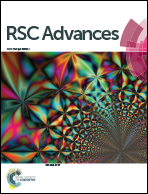Improving ternary blend morphology by adding a conjugated molecule into non-fullerene polymer solar cells†
Abstract
The use of ternary polymer solar cells (PSCs) is a promising strategy to enhance photovoltaic performance while improving the fill factor (FF) of a device, but is still a challenge due to the complicated morphology. Herein, ternary PSCs are fabricated via adding the conjugated small molecule p-DTS(FBTTh2)2 into a well-known blended film, PTB7-Th:IEICO-4F. The ternary blend morphology and device characterization reveal that the addition of p-DTS(FBTTh2)2 can improve crystallinity and optimize morphology, leading to the FF of the optimized device increasing to 73.69%. In combination with the advantages of an ultra-narrow bandgap material, IEICO-4F, with a broad optical absorption spectrum, the optimized ternary solar cell exhibits a high short-circuit current–density (JSC) of 25.22 mA cm−2. The best power conversion efficiency (PCE) is 12.84% for this optimized ternary device with 10 wt% p-DTS(FBTTh2)2 in the donors. This work indicates that incorporating a small molecule with high crystallinity into host binary non-fullerene PSCs would give an active layer with high crystallinity, thus greatly enhancing the FFs and PCEs of PSCs.



 Please wait while we load your content...
Please wait while we load your content...